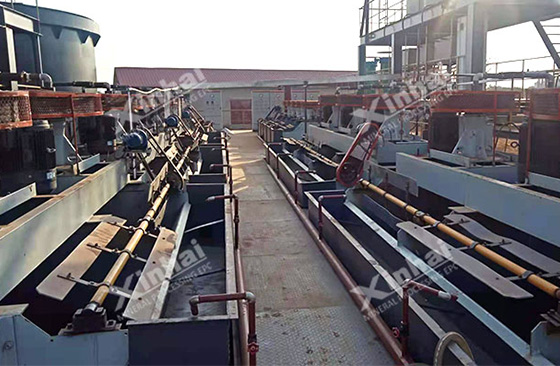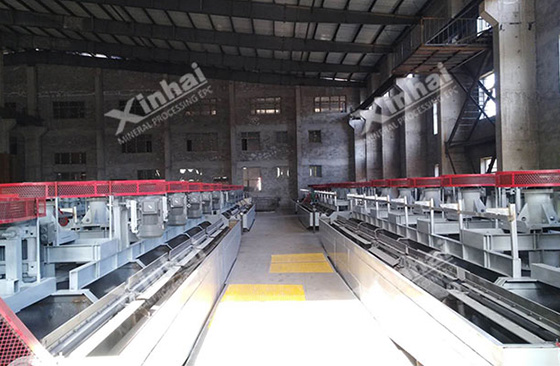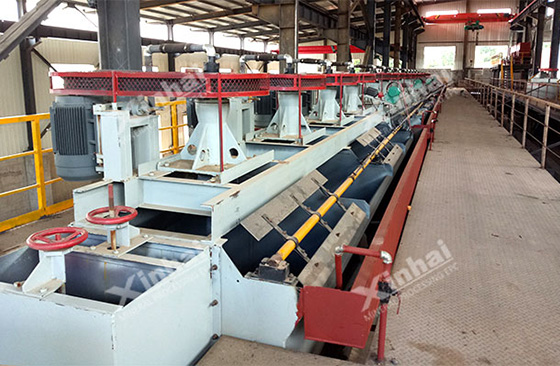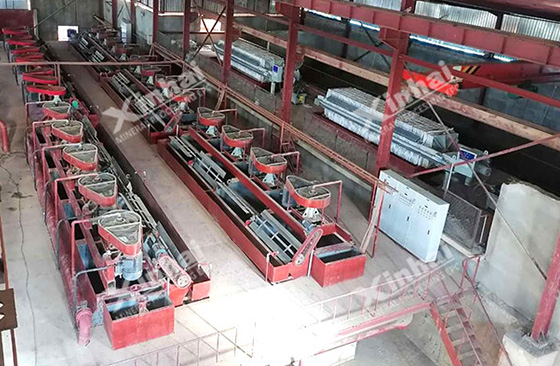
In antimony-bearing gold ores, the main target minerals are stibnite, natural gold, pyrite, arsenopyrite, etc. Pyrite and arsenopyrite are the main gold-carrying minerals. Some stibnite also contains gold, arsenopyrite and pyrite containing arsenic. Because the gold in the antimony-bearing gold ore is embedded in fine grains, the stibnite consumes cyanide and oxygen, so the flotation method is often used for recovery.

In production, in addition to the recovery of coarse-grained natural gold by gravity separation, the beneficiation of this type of gold ore focuses on the flotation separation of iron pyroxite, pyrite, arsenopyrite and other minerals. The preferential flotation method and the mixed-preferred flotation method are mostly used. According to the specific agent used, the flotation method of antimony gold ore can be subdivided into sodium hydroxide method, sodium sulfide-sodium hydroxide or sodium carbonate method, oxidant method and butylammonium black medicine method.
Sodium hydroxide is added to the ball mill, and the stibnite is inhibited by the grinding operation in the strong alkaline pulp. Copper sulfate activates pyrite and arsenopyrite, then adjusts the pH value of the slurry to 8-9, adds collectors and foaming agents, and preferentially floats pyrite and arsenopyrite to obtain gold concentrate. Then lead salt or copper salt is added to the tailings to activate the antimony ore, and then a collector and a foaming agent are added for flotation separation to obtain antimony concentrate.

Antimony gold ore sodium sulfide-sodium hydroxide or sodium carbonate flotation is to add sodium hydroxide and sodium carbonate in the grinding process, and then add lead acetate, copper sulfate, butyl xanthate and sulfuric acid for mixed flotation to obtain antimony gold Mixed concentrate with abandoned tailings. The antimony-gold mixed concentrate is sent to the regrinding operation, and sodium hydroxide, butyl xanthate, and copper sulfate are added during the grinding process and aerated. Then carry out flotation separation to obtain gold coarse concentrate, and the product in the flotation tank is antimony concentrate. Subsequently, the crude gold concentrate is selected by the sodium sulfide-sodium hydroxide method to inhibit the stibnite, and finally gold concentrate and low-grade antimony concentrate are obtained.
Add oxidant bleaching powder (CaOCl₂) or potassium permanganate (KMnO4) before the flotation separation of the mixed concentrate, keep the pulp solid-liquid ratio at 1:3, and the stirring time is 1min. Then add lead acetate 100g/t, use xanthate as collector to flotate stibnite, and the tailings are gold-bearing pyrite concentrate.

The use of butylammonium black medicine has a strong ability to collect antimony and has good selectivity, while the characteristics of arsenopyrite and pyrite with weak collecting ability are used for antimony gold flotation separation. First, in the grinding-classifying circuit, the coarse-grained single natural gold is immediately selected by the gold trap or the gravity separation method. Then, the preferential flotation process is adopted, the lead salt is used as the activator of stibnite, and the pH value of the pulp is adjusted with sulfuric acid. Butyl ammonium black medicine is used as collector, terpineol oil is used as foaming agent, and antimony concentrate is obtained by flotation of stibnite in natural pH or weak acid pulp. The flotation tailings are coarse arsenopyrite (pyrite) concentrates containing gold (due to the weak ability of butylammonium black drug to collect arsenopyrite). Then the tailings are added with butyl xanthate, activated by adding copper sulfate if necessary, and a frother is added to flotate the gold-containing arsenopyrite concentrate, and gold is extracted from it. Gold in antimony concentrate can be comprehensively recovered during the smelting process.

The reason why antimony-containing gold ore is difficult to recover is that on the one hand, antimony minerals encapsulate gold, and on the other hand, stibnite consumes cyanide and oxygen during leaching. The conventional direct cyanidation leaching method cannot obtain high beneficiation index. In practice, the flotation method is mostly suitable for processing ores of antimony minerals other than the carrier mineral type of gold. Its essence is the flotation separation of antimony minerals and gold-carrying minerals such as sulfur and arsenic, which avoids complex pretreatment links, and at the same time can obtain by-product antimony concentrate with relatively low cost. However, while ensuring the flotation index of antimony concentrate, it is necessary to reduce the entrainment of gold as much as possible.
To find out more about our products and solutions, please fill out the form below and one of our experts will get back to you shortly.